人教版七年级英语上册Unit1教案
- 格式:doc
- 大小:57.00 KB
- 文档页数:13
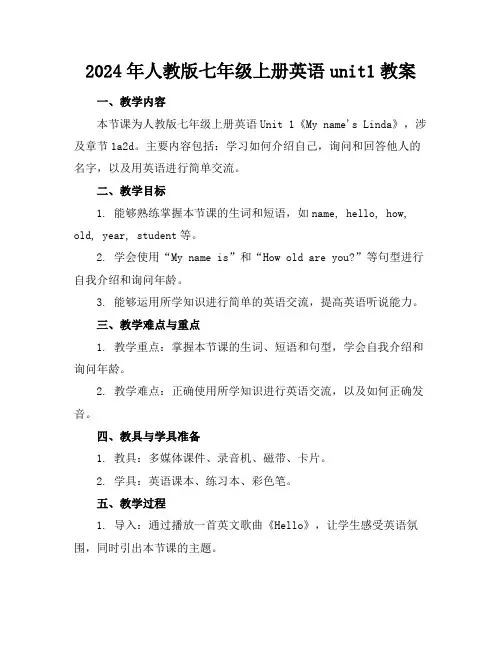
2024年人教版七年级上册英语unit1教案一、教学内容本节课为人教版七年级上册英语Unit 1《My name's Linda》,涉及章节1a2d。
主要内容包括:学习如何介绍自己,询问和回答他人的名字,以及用英语进行简单交流。
二、教学目标1. 能够熟练掌握本节课的生词和短语,如name, hello, how, old, year, student等。
2. 学会使用“My name is”和“How old are you?”等句型进行自我介绍和询问年龄。
3. 能够运用所学知识进行简单的英语交流,提高英语听说能力。
三、教学难点与重点1. 教学重点:掌握本节课的生词、短语和句型,学会自我介绍和询问年龄。
2. 教学难点:正确使用所学知识进行英语交流,以及如何正确发音。
四、教具与学具准备1. 教具:多媒体课件、录音机、磁带、卡片。
2. 学具:英语课本、练习本、彩色笔。
五、教学过程1. 导入:通过播放一首英文歌曲《Hello》,让学生感受英语氛围,同时引出本节课的主题。
2. 新课展示:展示多媒体课件,呈现本节课的生词、短语和句型,引导学生跟读并模仿。
3. 例题讲解:以PPT形式展示例题,讲解如何用英语进行自我介绍和询问年龄,并引导学生进行实际操作。
4. 随堂练习:发放练习纸,让学生两人一组进行角色扮演,练习自我介绍和询问年龄。
5. 小组活动:将学生分成若干小组,进行“Find your partner”的游戏,要求学生用英语进行交流,找到与自己年龄相仿的伙伴。
六、板书设计1. Unit 1 My name's Linda2. 生词:name, hello, how, old, year, student等3. 句型:My name is How old are you? I'm七、作业设计1. 作业题目:(1)抄写本节课的生词、短语和句型,每个三遍。
(2)用英语写一篇自我介绍,包括姓名、年龄和兴趣爱好。
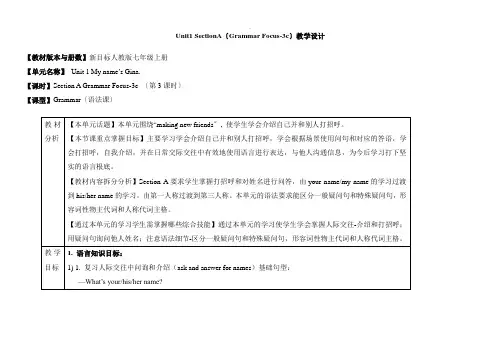
Unit1 SectionA〔Grammar Focus-3c〕教学设计【教材版本与册数】新目标人教版七年级上册【单元名称】Unit 1 My name’s Gina.【课时】Section A Grammar Focus-3c〔第3课时〕【课型】Grammar〔语法课〕教学评价1.本课时的目标设计清晰可操作,活动的设计紧扣目标要求并与目标达成一致。
2.语法练习中的活动设计遵循语言规律,由易到难逐层递进,充分表达语言输入到语言输出的完整过程。
3.语法练习的活动设计表达对文本内容的深度挖掘和文本再构,表达了对学生思维品格的训练与培养。
〔附教学设计〕步骤过程措施目的持续性评价1预备与激活先期知识Step 1Revision &Lead inI. Finish 3c,Practice introducing yourself and othersin a group. How many names can you remember?。
II. Ask and answer: Do you know them?Watch a video.1.通过教室场景和学生刚入学很多人还彼此不认识,营造与学生生活密切相关的语言学习气氛,由询问学生姓名复习句子,激起学生兴趣。
2.通过问答what’s her/his name引出Zootopia的视频, 设置故事悬念:完成5个任务,帮忙找到信息碎片,找到失踪的Mr. Mole。
通过介绍同学,检查学生是否能用已经学过的目标词汇和句型进展问答Mr. Mole is lost(失踪了), you need to finish following tasks to get a piece of message to help Judy.2获取新知Step 2GrammarFocus(Presentation)Task 1Look at the form in Grammar Focus(观察GrammarFocus表格)Find what questions and Yes/No questions inGrammar Focus and tell the differences(区别)QuestionsBeginwith___Answerwith___Innotationris e↗or fall↘whatYes/NoTask 2 Look at the form in Grammar Focus, tell thedifference between myand I.1.能初步理解区分一般疑问句和特殊疑问句。
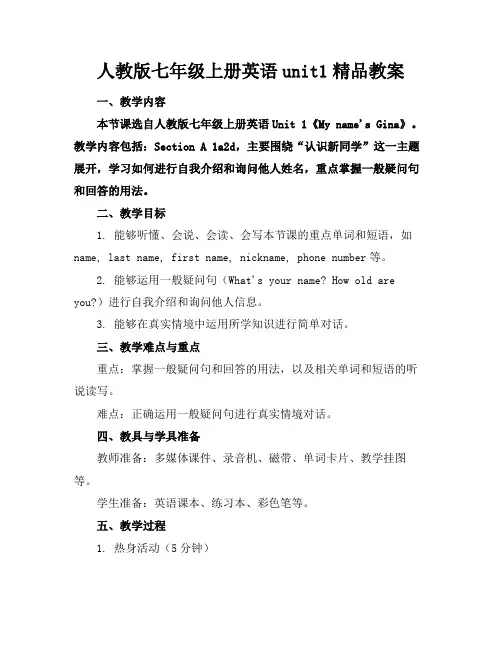
人教版七年级上册英语unit1精品教案一、教学内容本节课选自人教版七年级上册英语Unit 1《My name's Gina》。
教学内容包括:Section A 1a2d,主要围绕“认识新同学”这一主题展开,学习如何进行自我介绍和询问他人姓名,重点掌握一般疑问句和回答的用法。
二、教学目标1. 能够听懂、会说、会读、会写本节课的重点单词和短语,如name, last name, first name, nickname, phone number等。
2. 能够运用一般疑问句(What's your name? How old are you?)进行自我介绍和询问他人信息。
3. 能够在真实情境中运用所学知识进行简单对话。
三、教学难点与重点重点:掌握一般疑问句和回答的用法,以及相关单词和短语的听说读写。
难点:正确运用一般疑问句进行真实情境对话。
四、教具与学具准备教师准备:多媒体课件、录音机、磁带、单词卡片、教学挂图等。
学生准备:英语课本、练习本、彩色笔等。
五、教学过程1. 热身活动(5分钟)1.1 教师播放英文歌曲,引导学生跟唱,营造轻松的英语学习氛围。
1.2 学生进行小组活动,用中文进行自我介绍,为新课学习打下基础。
2. 新课导入(10分钟)2.1 教师展示教学挂图,引导学生学习新单词和短语。
2.2 学生跟读新单词和短语,并进行角色扮演,练习自我介绍。
3. 课堂讲解与练习(15分钟)3.1 教师讲解一般疑问句的用法,并进行例句演示。
3.2 学生进行角色扮演,用一般疑问句进行询问和回答。
3.3 教师展示多媒体课件,引导学生完成1a2d的练习。
4. 随堂练习(10分钟)4.1 学生完成教材2a2d的练习,巩固所学知识。
4.2 教师选取学生进行口头练习,检查学习效果。
5. 小组活动(10分钟)5.1 学生分组,进行“认识新同学”的对话练习。
5.2 教师巡回指导,纠正发音和语法错误。
6.2 学生分享学习心得,提出疑问。
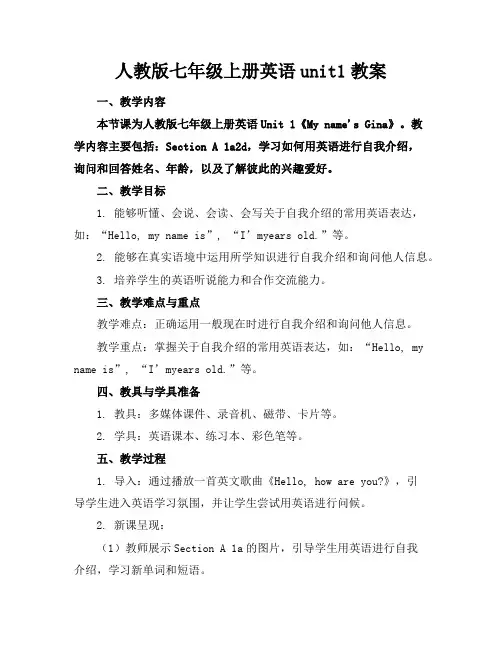
人教版七年级上册英语unit1教案一、教学内容本节课为人教版七年级上册英语Unit 1《My name's Gina》。
教学内容主要包括:Section A 1a2d,学习如何用英语进行自我介绍,询问和回答姓名、年龄,以及了解彼此的兴趣爱好。
二、教学目标1. 能够听懂、会说、会读、会写关于自我介绍的常用英语表达,如:“Hello, my name is”, “I’myears old.”等。
2. 能够在真实语境中运用所学知识进行自我介绍和询问他人信息。
3. 培养学生的英语听说能力和合作交流能力。
三、教学难点与重点教学难点:正确运用一般现在时进行自我介绍和询问他人信息。
教学重点:掌握关于自我介绍的常用英语表达,如:“Hello, my name is”, “I’myears old.”等。
四、教具与学具准备1. 教具:多媒体课件、录音机、磁带、卡片等。
2. 学具:英语课本、练习本、彩色笔等。
五、教学过程1. 导入:通过播放一首英文歌曲《Hello, how are you?》,引导学生进入英语学习氛围,并让学生尝试用英语进行问候。
2. 新课呈现:(1)教师展示Section A 1a的图片,引导学生用英语进行自我介绍,学习新单词和短语。
(2)教师播放1b的录音,学生跟读,学习正确的发音。
(3)学生两人一组,根据2a的提示,互相提问并回答关于姓名、年龄、兴趣爱好等问题。
3. 情景交际:(1)教师创设真实语境,引导学生运用所学知识进行自我介绍和询问他人信息。
(2)学生分角色进行角色扮演,模拟真实场景。
4. 例题讲解:(1)教师讲解一般现在时的用法,并结合例句进行展示。
(2)学生完成Section A 2b的练习,巩固一般现在时的用法。
5. 随堂练习:(1)学生完成Section A 2c的练习,进行听力训练。
(2)学生两人一组,根据2d的提示,互相提问并回答问题。
(1)教师邀请学生分享本节课的学习收获。
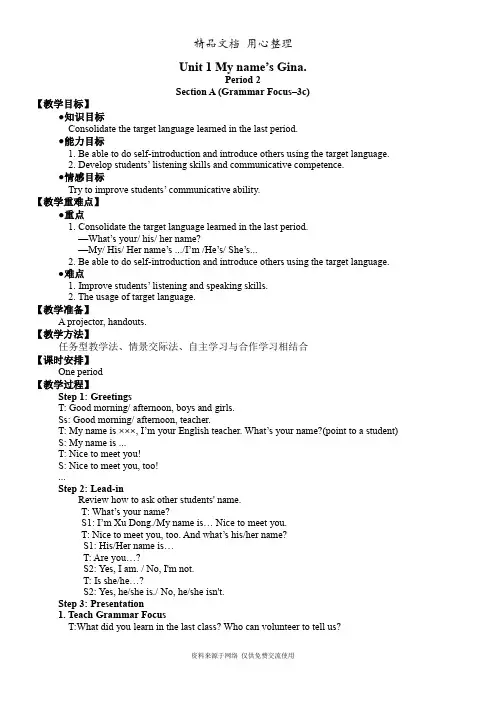
Unit 1 My name’s Gina.Period 2Section A (Grammar Focus–3c)【教学目标】●知识目标Consolidate the target language learned in the last period.●能力目标1. Be able to do self-introduction and introduce others using the target language.2. Develop students’ listening skills and communicative competence.●情感目标Try to improve students’ communicative ability.【教学重难点】●重点1. Consolidate the target language learned in the last period.—What’s your/ his/ her name?—My/ His/ Her name’s .../I’m /He’s/ She’s...2. Be able to do self-introduction and introduce others using the target language.●难点1. Improve students’ listening and speaking skills.2. The usage of target language.【教学准备】A projector, handouts.【教学方法】任务型教学法、情景交际法、自主学习与合作学习相结合【课时安排】One period【教学过程】Step 1: GreetingsT: Good morning/ afternoon, boys and girls.Ss: Good morning/ afternoon, teacher.T: My name is ×××, I’m your English teacher. What’s your name?(point to a student) S: My name is ...T: Nice to meet you!S: Nice to meet you, too!...Step 2: Lead-inReview how to ask other students' name.T: What’s your name?S1: I’m Xu Dong./My name is… Nice to meet you.T: Nice to meet you, too. And what’s his/her name?S1: His/Her name is…T: Are you…?S2: Yes, I am. / No, I'm not.T: Is she/he…?S2: Yes, he/she is./ No, he/she isn't.Step 3: Presentation1. Teach Grammar FocusT:What did you learn in the last class? Who can volunteer to tell us?S1:Me. We’ve learned how to introduce ourselves.S2:We’ve learned the use of verb be.S3:We’ve learned the possessive pronounces.T:Great! Today we’ll consolidate what we’ve learned in the last class.(1) Ask students to open their book, and turn to Page 3. Read through the sentences in the box.(2) Ask students to write down their answers to the questions, and substitute the names of the names of students in the box.(3) Leave students several minutes to do the task.(4) Collect their answers. Correct mistakes if there is any.(5) Ask students to read the short forms in the box. Pay attention to the pronunciation.2. Teach activity 3a(1) Look at 3a. Tell Ss to put the words in order to make conversations. Pay attention to theright sentence structure. Ss work with their partners. Try to make conversations with the given words.(2) Check the answers. Encourage some pairs to act out the dialogue. See if their dialogues are right.(3) Ss read the dialogue aloud after the teacher. Then try to practice the dialogues with their partners.(4) Let some pairs to act out the dialogue in front of the class.Step 4: Practice1. Teach activities 3b(1) Look at 3b. Tell Ss to complete conversation. Pay attention to the right sentence structure.Ss work with their partners. Try to make conversation.(2) Check the answers. Encourage some pairs to act out the conversations. See if their answers are right.(3) Ss read the conversations aloud after the teacher. Then try to practice the conversations with their partners.(4) Let some pairs to act out the conversations in front of the class.2. Teach activity 3c(1) Now, each of you has an English name. So we have learnt many names about boys and girls. Do you know how many foreign names? Let's do a "Name game".Competition: list names as many as possible, see which group gets the most names.(2) Divide the Ss into groups of six or more. Each group has four or six students.(3) Tell Ss how to play the game. Make a model for the Ss.S1: My name is Jenny.S2: Her name is Jenny. My name is Tony.S3: Her name is Jenny. His name is Tony…My name is June.S4: …(4) Ss play the game in their groups first. Then have a competition. See which group is the best.Step 5: ConsolidationSum up the possessive pronouns “my, your, his, her...”.Do exercises:1. What’s (你的) name?2. (我的) name is Jenny.= Jenny.3. What’s (他的) name?4. (他的) name is Tony.5. What’s (她的) name?6. (她的) name is Gina.Invite volunteers to present the answers.Answers:1.your 2. My; I’m 3.his 4.His 5.her 6.Her【课堂小结】In this period, we’ve consolidated what we’ve learned in the last period through some practice and games.【课后作业】1. Read the sentences in Grammar Focus.2. Make some conversations by yourself.。
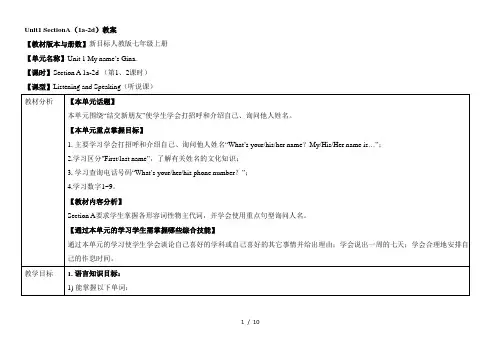
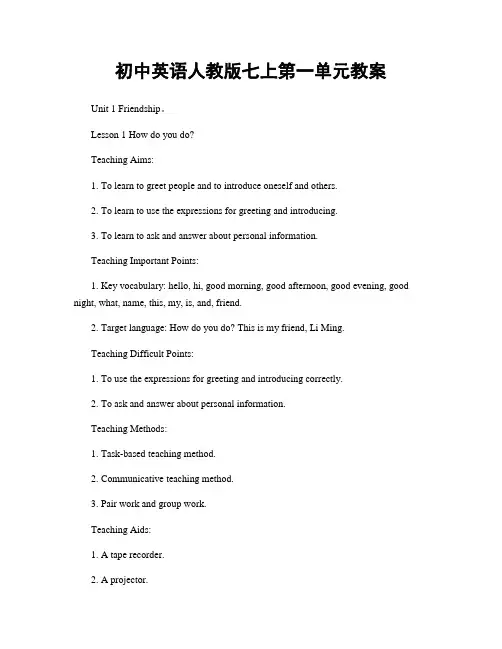
初中英语人教版七上第一单元教案Unit 1 Friendship。
Lesson 1 How do you do?Teaching Aims:1. To learn to greet people and to introduce oneself and others.2. To learn to use the expressions for greeting and introducing.3. To learn to ask and answer about personal information.Teaching Important Points:1. Key vocabulary: hello, hi, good morning, good afternoon, good evening, good night, what, name, this, my, is, and, friend.2. Target language: How do you do? This is my friend, Li Ming.Teaching Difficult Points:1. To use the expressions for greeting and introducing correctly.2. To ask and answer about personal information.Teaching Methods:1. Task-based teaching method.2. Communicative teaching method.3. Pair work and group work.Teaching Aids:1. A tape recorder.2. A projector.Teaching Procedures:Step 1. Warm-up。
1. Greet the students with different greetings, such as "Good morning, class" and "Hello, everyone".2. Ask the students to respond to the greetings.Step 2. Presentation。
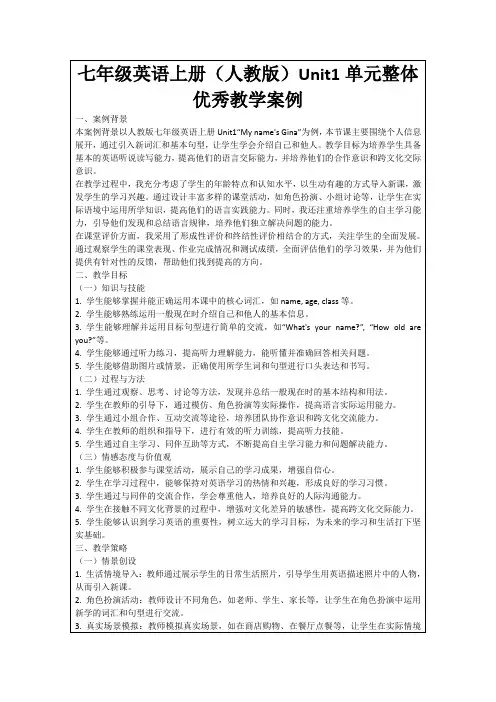
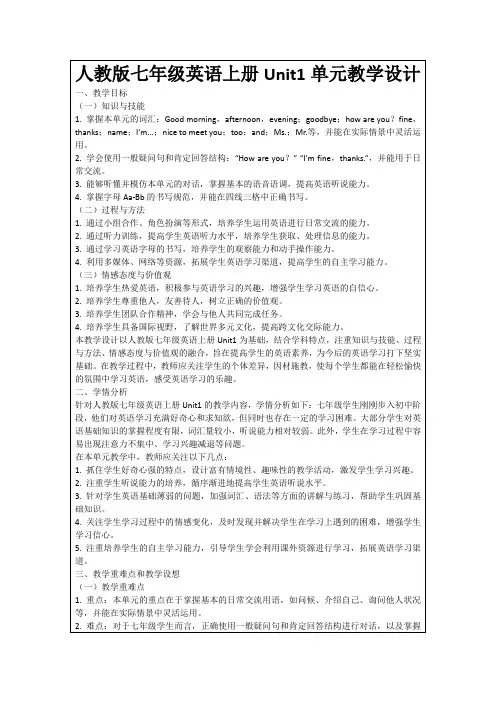
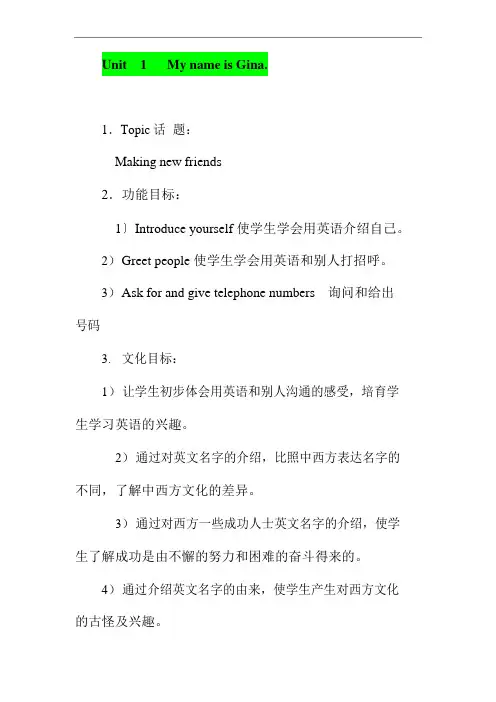
Unit 1My name is Gina.1.Topic 话题:Making new friends2.功能目标:1〕Introduce yourself 使学生学会用英语介绍自己。
2)G reet people 使学生学会用英语和别人打招呼。
3)A sk for and give telephone numbers 询问和给出号码3.文化目标:1)让学生初步体会用英语和别人沟通的感受,培育学生学习英语的兴趣。
2)通过对英文名字的介绍,比照中西方表达名字的不同,了解中西方文化的差异。
3)通过对西方一些成功人士英文名字的介绍,使学生了解成功是由不懈的努力和困难的奋斗得来的。
4)通过介绍英文名字的由来,使学生产生对西方文化的古怪及兴趣。
4.认知目标:1〕词汇:clock, hello, hi, and, question, answer, look, first name, last name2)语法工程:一般现在时be 的用法以特别疑问词what 开头的问句形容词性物主代词my, your, his, herWhat’s=What is I’m=I am My name’s=My name is3)Language goals 语言目标:What’s your name?My name is Gina.I’m Gina. Nice to meet you.What’s your telephone number? It’s….Period oneI.教材分析:这是课本的第一局部,题目是My mane is Gina. 有很多学生第一次学习接触英语,为了调动他们的乐观性,不产畏难心情,尽量简洁的处理教材。
Language topic: What’s your name?My name is Gina.Language strategies: Talk about the namesMain vocabulary: name is, meet, his, first name, last name, answer, boy , girl.II.语言结构: present tense to be, what questions, Possessive adj. my, your, his, her. 。
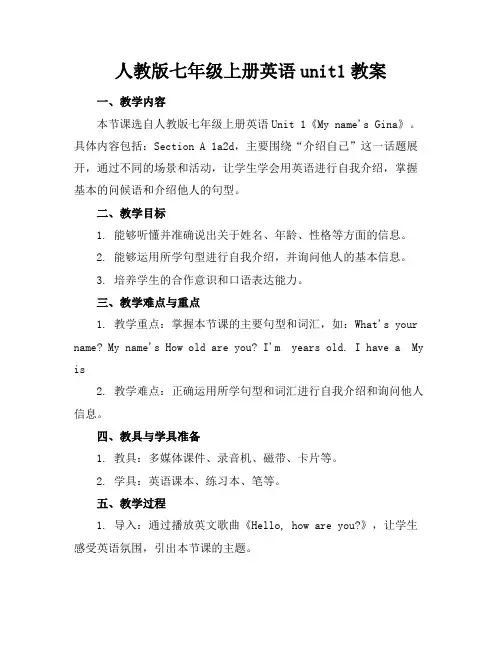
人教版七年级上册英语unit1教案一、教学内容本节课选自人教版七年级上册英语Unit 1《My name's Gina》。
具体内容包括:Section A 1a2d,主要围绕“介绍自己”这一话题展开,通过不同的场景和活动,让学生学会用英语进行自我介绍,掌握基本的问候语和介绍他人的句型。
二、教学目标1. 能够听懂并准确说出关于姓名、年龄、性格等方面的信息。
2. 能够运用所学句型进行自我介绍,并询问他人的基本信息。
3. 培养学生的合作意识和口语表达能力。
三、教学难点与重点1. 教学重点:掌握本节课的主要句型和词汇,如:What's your name? My name's How old are you? I'm years old. I have a My is2. 教学难点:正确运用所学句型和词汇进行自我介绍和询问他人信息。
四、教具与学具准备1. 教具:多媒体课件、录音机、磁带、卡片等。
2. 学具:英语课本、练习本、笔等。
五、教学过程1. 导入:通过播放英文歌曲《Hello, how are you?》,让学生感受英语氛围,引出本节课的主题。
2. 展示:展示Section A 1a2d的内容,引导学生学习新句型和词汇。
3. 实践:a. 学生两人一组,互相进行自我介绍。
b. 教师邀请几名学生上台进行示范,其他学生认真听并模仿。
c. 学生分组进行角色扮演,模拟不同的场景进行自我介绍。
4. 互动:进行课堂小游戏,巩固所学内容。
5. 巩固:教师出示卡片,学生用所学句型进行问答。
六、板书设计1. Unit 1 My name's Gina2. 主要句型和词汇:What's your name? My name'sHow old are you? I'm years old.I have a My isname, age, school, class, friend七、作业设计1. 作业题目:a. 根据所给提示,用英语进行自我介绍。
人教版七年级英语上册Unit1Myname'sGina教案人教版七年级英语Unit1 My name s Gina教案1. 让学生学会向别人做自我介绍,学会交朋友。
2. 学会使用与他人见面时的问候语。
3. 学会电话号码的表达方法并能向他人索取电话号码。
单元教学目标1. 语言知识目标1) 学生能听、说、读、写课标内单词 zero-nine,phone number,first name /last name , hi, hello 等。
2) 学生学会运用这些句型:a. what’s your/her/his nameb. hello. nice to meet you.c. what’s her last/first named. what’s your phone number it’s…2. 语言技能目标1) 能正确流利地用英语向他人介绍自己,并乐于与同伴交往。
2) 能正确使用问候语。
3) 能积极主动提供并获取个人信息资料(如:名字、电话号码)4) 能对所获取的信息进行初步的整理和总结。
5) 能归纳一定的语言现象。
(如:what is =what’s he is =he’s 等 )3. 学习策略目标a) 能积极与同伴合作,共同完成学习任务。
b) 能通过网络等多种资源获得相关信息,拓展所学知识。
c) 能积极动手、动脑,培养自己的想象力和创造力。
4. 情感态度目标1. 使学生对英语产生强烈的兴趣和愿望,乐于参加各种语言实践活动。
2. 能与伙伴团结一致、友好相处,学会如何礼貌地与他人交往。
5. 文化意识目标1. 学生能了解和运用英语中常见的问候语。
2. 能初步了解英语国家的姓名。
教学重点1. 让学生学会自我介绍,学会交朋友。
2. 正确使用问候语。
3. 能听懂并说出0-9的数字。
教学难点1. 能正确使用人称代词my , your, his, her, i2. 英语名字的认读怎么学习英语最快好制定了学习英语计划,首先,从提高阅读能力开始。
2024年人教版七年级上册英语unit1标准教案一、教学内容本节课教学内容来自2024年人教版七年级上册英语Unit 1《My name's Linda》。
具体包括:Section A 1a2d,主要围绕“见面和自我介绍”这一主题展开,涉及日常交际用语、名词、形容词性物主代词、be动词等知识点。
二、教学目标1. 能够听懂、会说、会读、会写与“见面和自我介绍”相关交际用语,如:“Hello, my name is”, “What's your name?”, “I'm”等。
2. 能够正确运用名词和形容词性物主代词,介绍自己和他人名字、年龄、爱好等。
3. 能够运用be动词一般现在时形式,描述自己和他人特点。
三、教学难点与重点1. 教学重点:名词、形容词性物主代词和be动词一般现在时正确运用。
2. 教学难点:如何引导学生运用所学知识点进行自然自我介绍和交流。
四、教具与学具准备1. 教具:多媒体课件、录音机、磁带、黑板、卡片等。
2. 学具:课本、练习本、彩色笔等。
五、教学过程1. 引入:通过播放一首英文歌曲《Hello, how are you?》,引导学生进入英语学习状态,同时复习上节课知识点。
2. 新课展示:(1)展示Section A 1a图片,引导学生观察并回答问题,如:“Who are they?”等。
(2)播放1a录音,让学生跟读并模仿,掌握“Hello, my name is”等交际用语。
(3)引导学生相互介绍,进行小组活动。
3. 例题讲解:(1)讲解2a例题,让学生解如何用be动词描述自己特点。
(2)引导学生进行2b练习,巩固所学知识点。
4. 随堂练习:(1)让学生完成2c练习,相互询问对方名字和年龄。
(2)引导学生进行2d小组活动,练习自我介绍。
六、板书设计1. 主题:My name's Linda2. 内容:(1)交际用语:Hello, my name is / What's your name? /I'm(2)名词:name, age, hob等(3)形容词性物主代词:my, your, his, her等(4)be动词一般现在时:am, is, are七、作业设计1. 作业题目:(1)抄写并背诵本节课交际用语和重点句型。
人教版(新目标)初中七上Unit 1 My name's Gina教案Period OneTeaching aims(教学目标)1.学会问候他人2.学会如何做自我介绍, 认识新朋友,并正确称呼他们的英文名字3.从对话中学会获取更多他人的基本信息5.初步学会使用部分形容词性物主代词Language points(语言点)`1.要求掌握以下句式:(1)—What’s your name—My name is…(2)—Hi. My name’s Gina.—I’m Jenny. Nice to meet you!--- Nice to meet you, too.(3)what’s =what is I’m =I am name’s =name is2.要求掌握以下词汇:(1)生词:name, am, nice, meet, what, hello"(2)人称代词和形容词性物主代词:I, you, my, your, his, her(上述数词和部分形容词性物主代词本应在第二和第三课时中出现,但可以在第一课时中非正式出现,给学生初步的印象,为后面的学习作铺垫。
)Difficulties(难点):本课难点是大量的人名和形容词性物主代词,而学生在描述时容易混淆男名和女名,在运用代词时容易错用人称代词和物主代词。
Teaching steps(教学步骤)1. Warming-up and revision(课堂热身和复习)(1) Play the tape, enjoy the ABC song or Hello song, get the Ss to sing together.(2)Warm greetings to the students2T: Hello! / Hi!#S: Hello! / Hi!T: You are very beautiful/cool/…S: Thank you.2. Presentation(呈现新知识)(1)T: Hello! My name is Lily. What’s your nameS: (引导学生回答) My name is Tom.T: It’s a good / nice name.I like your name.'教学设计说明1.在课前放一段学生熟悉的英文歌曲,渲染学习气氛。
在轻快的音乐中学习,使学生更乐学。
2.跟学生热情地打招呼,赞美学生,尽快缩短师生之间的距离。
如学生未能理解,可用汉语补充解释。
3.T重复两遍这两句话,然后板书my / your / what’s在黑板上,并在与学生交流的时候加重my/your的语音,突出这两个单词。
4.T要及时表达对学生名字的欣赏。
(2)T: Hi! I’m Lily. / My name’s Lily.S: (引导学生回答)Hi! Lily. I’m Alan.T: Nice to meet you!;S: Nice to meet you!(3)Practice the expressions on the blackboard. Tell the Ss to pay attention to: what’s=what is I’m=I am name’s=name is3. Play a game. (show the Ss a bag with fruits and two boxes full of English names)T: Look here. I have a lot of gifts for you. Come here and touch. Try to say them in English, I’ll give you the gift and let you choose an English name first.S: Yeah.S1:(获得英文名后) My name’s…/ I’m…S(全班): Nice to meet you!S1: Nice to meet you!—4. Work on 1aT: Now look at the pictures 7 on P1. Listen and Read. Try to say and write English words for the things in the picture See how many words you know.T: Look here. What’s this Who knows(Reward the student if she / he knows the word,write some new words on the blackboard to teach the Ss, such as map…)5.Work on 1bT: Now let’s listen to the tape, find out the right conversation,and number them 1-3.(Point out the boxes where students will write a number for each conversation. Play the recording for the first time, Ss only listen. Then play a second time, Ss number the conversations.)□A:What’s your name □A:Good morning! □A: Hi. My name’s Gina.}B: Alan. I’m Cindy. B: I’m Jenny. Nice to meet you!A: Hello, Alan. I’m Ms Brown. B: Hello, C indy. I’m Dale. A: Nice to meet you, too.A: Nice to meet you!6.Work on 1c(1)Ask the Ss to practice the conversations in 1b with a use their own names to practice instead of the names given.(2)Encourage the Ss to leave their seats, move around and greet other classmates.5.引出另一种表达方式I’m / name’s,T板书这两个词。
同时让学生学会初次见面说Nice to meet you. 并且彼此握握手,告诉他们这是一个礼节,在美国很普遍。
新句型的出现需多遍重复,加深学生的印象。
6.有部分同学没有英文名字,为了便于后面的交流,通过有趣的游戏,让他们在活动中获得奖赏。
也可以让他们回答一些简单的问题来得到选名字的机会。
同时巩固前面的句型。
…7.把图上的东西在实物投影仪上放大,或者课前画一些简笔画。
使图像更清晰、直观。
8.播放磁带, 训练学生准确获取信息的能力,同时检测一下学生对新句型的掌握情况。
如有需要,T可播放磁带两遍,播放之前,向学生讲清练习听力的步骤。
听完检验答案后,有必要以大组为单位重复操练一下这三组句型。
9.在学生两人小组进行对话时,教师可在教室不同的位置走动,聆听同学们的对话,及时肯定他们的进步,并在他们需要的时候提供帮助,纠正不正确的语音语调。
(3)Get some pairs to come to the front of the class and act out the dialogue after they have practiced several times.7.Follow up(进一步扩展)(1)(Take out some photos of famous persons, such as athletes, film stars, singers and so on)T: Well, I’d like to show you some pictures you are interestedin. Can you tell me what her / his name is"What’s his / her nameHer / His name is…T: Great. / Wonderful. / Good. / Right. / Well done.(Write down their names on the blackboard to make the Ss read more easily and remember more English names.)(2)T: I’m sure you’ll b e famous like them one day. So first you need to make a calling card.(Give each student an empty card for them to write their English names on one side and Chinese names on the other side, then hang them before their chests.)8.HomeworkOral work:/(1) Listen to 1b, read and recite it. (听读背诵1b中的对话)(2) Go on making up your dialogues with your group members and polish it. (继续和小组成员编对话。
并完善对话。
)Written work:(1) Copy the phrases in 1a twice.(2) Write English names as many as possible in the exercises book.课后反思:*人教版(新目标)初中七上Unit 1 My name's Gina教案Period TwoTeaching aims(教学目标)1.继续学习如何做自我介绍及问候他人。
2.学会从对话中获取对方的基本信息(询问他人姓名)。
.Language points(语言点)1.要求掌握以下句式:What’s your/his/her name-My/His/Her name is ……2.要求掌握下列词汇:his, and, her, question, answer, look3.语法:了解缩略形式What is=What’s ,I am = I’m等;初步了解代词my,your,his,her的用法(此知识可在今后学习中进一步巩固)。